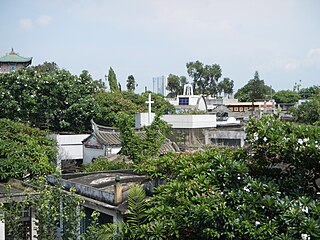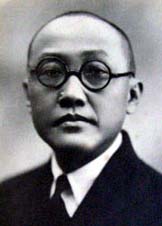
Tiong Ghee Temple is a Taoist temple on Stirling Road in Queenstown, Singapore. It is the oldest Taoist temple in Queenstown.

Tiong Ghee Temple is a Taoist temple on Stirling Road in Queenstown, Singapore. It is the oldest Taoist temple in Queenstown.
The Tiong Ghee Temple was built to replace an older temple in the Boh Beh Kang village, which had been demolished in 1968 to make way for the development of the Mei Ling estate. The older temple, which was initially known as the Ghee Tiong Temple, was built on Hong Yin Hill following the end of World War II and replaced an even older temple in the village that had been converted from a storage hut in the 1930s. It was renamed the Tiong Ghee Temple in 1966. [1] Fundraising for the newer temple began shortly after the demolition of the previous temple. It was officially opened by prominent businessman Chua Poh Tiong in 1973. [2] [3] The temple is dedicated to the deity Guan Gong. [1] It still features the original altar statues. Although there had not been a Taoist medium at the temple for over a decade by 2010, the original medium's chair, spirit whip and sword are still kept at the temple. [4]

Queenstown is a planning area and satellite residential town situated on the south-westernmost fringe of the Central Region of Singapore. It borders Bukit Timah to the north, Tanglin to the northeast, Bukit Merah to the east and southeast, as well as Clementi to the northwest and west. Its southern and southwesternmost limits are bounded by the Pandan Strait.
Tiong Bahru is a housing estate and subzone region located within Bukit Merah planning area, in the Central Region of Singapore. Tiong Bahru was constructed in the 1920s by the Singapore Improvement Trust, the predecessor to the Housing Development Board (HDB) and an entity of the British colonial authority providing mass public housing in Singapore and is the oldest housing estate in Singapore.

The Armenian Church of Saint Gregory the Illuminator, referred to locally as the Armenian Church, is the oldest Christian church in Singapore, located at Hill Street in the Museum Planning Area, within the Central Area. The church was completed in 1835 and consecrated the next year. Originally a parish of the Armenian Apostolic Church, an Oriental Orthodox denomination, the last Armenian parish priest left in the late 1930s as Armenian population in Singapore dwindled. It was designated as a national monument in 1973. Armenian and Oriental Orthodox services are now regularly held at the church.

Yueh Hai Ching Temple, also known as the Wak Hai Cheng Bio from its Teochew pronunciation, is a Chinese temple in Singapore located in Raffles Place in Singapore's central business district. The temple, whose name literally means "Temple of the Calm Sea", was the first stop for Chinese immigrants to Singapore in the early 19th century. The temple was gazetted as a national monument of Singapore in 1996. It had also won various awards for its heritage and conservation efforts.

Na Tuk Gong are local guardian spirits worshipped by overseas Chinese communities in Malaysia, Singapore and parts of Indonesia, especially Sumatra. An alternate more generic name for the cult is Datuk Gong, uniting Dato or Datuk from the local Malay word for 'grandfather', which is also used as an honorific title, and Kong or Gong from Chinese, also an honorific title. According to Taoist tradition, a Na Tuk Kong's could hold the official title 拿督尊王. It is important to note that Datuk Keramat, Datuk Gong and Na Tuk Kong all refer to the same deity. For the sake of clarity, the term Datuk, which is universally used to describe the spirit in Malaysia, will be used.

The North-East Region of Singapore is one of the five regions in the country. The region is the most densely populated and has the highest population among the five, with Sengkang being its most populous town as of 2020 and Seletar as the regional centre. Comprising 13,810 hectares, it includes seven planning areas and is largely a residential region with 217,120 homes. Housing largely consists of high-density HDB public housing estates, however private housing is also present in the region. As its name implies, it is located in the north-eastern part of Singapore.

The Manila Chinese Cemetery is the second oldest cemetery in Manila after La Loma Cemetery. The cemetery includes Christian, Buddhist and Taoist burials. The present-day cemetery is a vaguely trapezoidal area of about 54 hectares with an irregular network of roads its old pre-war part along Rizal Avenue Extension, reflecting its gradual evolution and expansion. Meanwhile, the post-war portion has three major roads bisected by minor roads, aligned northwest to southeast. Matandang Sora, coming from the main entrance in Felix Huertas going towards Chong Hock Temple, is the main road today. Before the Pacific War the main entrances faced Avenida Rizal. This northwestern is the oldest and most historically significant part of the cemetery. The cemetery was witness to many executions during World War II. Among them were Girl Scouts organizer Josefa Llanes Escoda, Filipino Brigadier General and hero during World War II and Boy Scouts of the Philippines charter member Vicente Lim, literary geniuses Liling Roces and Manuel Arguilla, star athlete-turned-guerrilla spy Virgilio Lobregat, and Chinese Consul General Yang Guangsheng. Apolinario Mabini was also buried in the cemetery before his remains were transferred to Batangas on July 23, 1956.

Lee Choon Seng was a businessman and philanthropist in pre-independence Singapore. He founded several companies, cultivated rubber plantations in Malaya and started Chinese banks in the region. Lee held leadership roles in several Chinese community organisations in Singapore, notably the Singapore Chinese Chamber of Commerce and Industry (SCCCI), and supported Sun Yat-Sen's revolutionary cause in China. In addition, he promoted the growth of Buddhism in Singapore by setting up several Buddhist institutions, including the Singapore Buddhist Lodge, Singapore Buddhist Federation and Poh Ern Shih Temple. In 2008, his life and contributions to society were commemorated in a memorial hall at the Ee Hoe Hean Club.
Singaporean Hokkien is a local variety of the Hokkien language spoken natively in Singapore. Within Chinese linguistic academic circles, this dialect is known as Singaporean Ban-lam Gu. It bears similarities with the Amoy spoken in Amoy, now better known as Xiamen, as well as Taiwanese Hokkien which is spoken in Taiwan.

Puning, officially Puning City, is a county-level city located in Eastern Guangdong, China, under the administration of the city, Jieyang. Nevertheless, its administrative power in economic matters is comparable to that of prefecture-level cities. Puning is geographically situated on the west rim of Chaoshan Plain, leaning against the stretching branch of the Lianhua Mountains at its southwest border, and 90 percent of its territory sits on the south of the Tropic of Cancer. The city has a population of 2.5089 million under its household registration system hukou, marking the largest in all county-level cities in China. Puning's downtown residents amount to 581,900, behind Yiwu, while the entire city's resident population of 1.9986 million is second to cities Kunshan and Jinjiang. It is concurrently the ancestral hometown of 1.95 million overseas Chinese people and 1.4 million 'returned overseas Chinese people' and family members of overseas Chinese people.

The Birthday of the Monkey God is a cultural and religious holiday celebrated in Singapore on the 15th or 16th day of the First Lunar Month. The dates on the Western Calendar vary from year to year. It marks the birthday of Sun Wukong, the protagonist in the classical novel Journey to the West. The popular celebratory customs associated with the Birthday of the Monkey God have both secular and religious (Taoist) themes. This is not to be confused with the Monkey King Festival celebrated in China on the 16th day of the Eighth Lunar Calendar.

My Queenstown Heritage Trail is a walking trail in Queenstown, Singapore. The trail was launched in 2010 by civic group, My Community, to promote the heritage, local culture and architectural styles in Queenstown.
Aw Cheng ChyeS.P.M.J., B.B.M., O.St.J was a Singaporean millionaire, businessman, company director, philanthropist and son of businessman Aw Boon Par. Aw Cheng Chye himself was the chairman of Haw Par Brothers (Private) Limited and Haw Par Brothers International Limited until his sudden death on 22 August 1971 in Santiago de Chile.
Lim Nang Seng was a Singaporean sculptor. He sculpted the Merlion statue in Merlion Park.

Tanglin Halt is a public housing estate, planning subzone and former industrial estate in Queenstown, Singapore. Most of the older buildings in the estate are set to be demolished by 2024 to make way for redevelopments under the Selective En bloc Redevelopment Scheme. It is the third housing estate to be redeveloped under the scheme.
Qi Tian Gong, commonly referred to as the Tiong Bahru Monkey God Temple, is a Taoist temple in Tiong Bahru, Singapore.

On 14 February 2016, 47-year-old unemployed Singaporean Loh Suan Lit hammered 53-year-old temple helper Tan Poh Huat to death at Choa Chu Kang Combined Temple, located at Singapore's Choa Chu Kang. Loh left for Malaysia five days after the killing, but he was arrested another five days later at the Woodlands Checkpoint on his way back to Singapore.

45, 48 and 49 Stirling Road are three residential flats on Stirling Road in Queenstown, Singapore. They were the first three blocks completed by the Housing and Development Board (HDB), having been previously left unfinished by its predecessor, the Singapore Improvement Trust.
The Great Madras, formerly the Grand Madras Hotel, is a boutique hotel in Singapore. Initially a Singapore Improvement Trust block, it became the Grand Madras Hotel in 1990s.